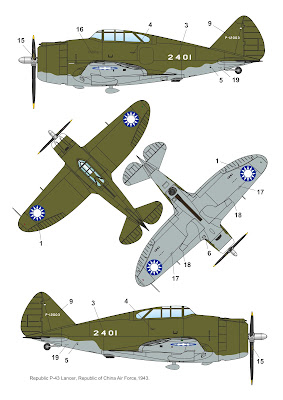One of the forgotten fighters of the Second World War is the Republic P-43 Lancer. A development of the Seversky P-35, and the predecessor to the well-known P-47 Thunderbolt, the Lancer carries a rather negative reputation, one that might be based on information that could be less than factual.
There is little available in written form on the Lancer. It has a few pages in the Squadron Signal Mini In Action, and it is a subject in the TopDrawings series by Kagero, coming in at a miniscule twenty pages. Yet the P-43 was built in larger numbers than many other World War II aircraft that have been detailed in several published works. The Lancer also saw combat over the skies of China - possessing a turbo-supercharger the Lancer could intercept high flying Japanese aircraft that the P-40 could not reach.
The first batch of pre-production P-43s were delivered to the Army Air Corps from September 1940 to April 1941. Although the plane exceeded USAAC performance goals, the goals, along with the YP-43, were already obsolete due to a lack of armor, lack of self-sealing fuel tanks, and not being as maneuverable as other aircraft. Due to delays in the P-47 development, the Lancer went into production, with the P-43A model having an improved engine and increased firepower with two .50 machineguns in the nose and one in each wing. Additional Lancers were ordered for China, and these aircraft did have pilot armor and self-sealing fuel tanks. This is proven by the issuance of part numbers for both by the USAAC. Therefore those Lancers sent to China, P-43A-1, offered slightly better protection than the P-43A model. One source that every P-43 skeptic should read is an article written by Rick Dunn. His detailed writing of the Lancer in Chinese service may convince the reader that the Lancer was not as bad as we think.
Performance of the A model sent for use with the American Volunteer Group showed that it was successful at high altitude and processed a high roll rate, while the radial engine was less susceptible to damage than the water-cooled inline engine found on the P-40, but that the fuel tanks in the wings leaked which caused fires to occur if the fuel came into contact with the turbo-supercharger that was located under the fuselage. The Japanese noted that the Lancer's wings could be easily punctured as well.
The P-43A-1 saw service in China's 4th Air Group. As a mediocre airplane, it saw both success and failure. There are few combat accounts, and details are lacking, but I plan to create a couple of Check Your 6! scenarios based on what information I can scrounge. Flying alongside P-40s, opponents were the Ki-43 and Ki-44 fighters, along with mid-war Japanese bombers and recon aircraft.
The P-43 is available from Flight Deck Decals and as Chinese paint schemes were rather plain in appearance, a set of Chinese roundels along with airplane numbers is all that one needs. The Lancers were received in standard USAAC colors (olive drab 43 and neutral gray 41), but were soon painted in the Chinese olive green. I believe that the under surfaces retained the neutral gray.
In game terms, the P-43 Lancer has already been rated by Tom Michael on the Check Your 6! discussion group. I've added a little information by including climb rates, as the Lancer had a comparable climb to the P-40B/C, significantly better than the F4F, and slightly better than its descendant, the P-47. I've increased the robustness on the A-1 model due to the pilot armor and self-sealing fuel tanks being added, although there is some debate on how effective those additions truly were. And I have added a aircrew check anytime the Lancer does maximum speed to see if it catches on fire.



No comments:
Post a Comment
I appreciate your comment and will review and add shortly!